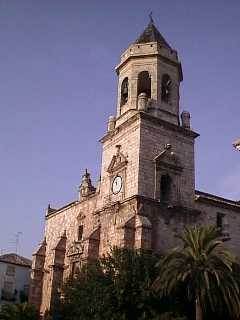Iglesia de San Juan Evangelista de Mancha Real
Monument
, Mancha Real
In its design and execution, the names of prestigious architects from the 16th to the 18th centuries are linked, such as Andrés de Vandelvira, master of the Andalusian Renaissance, Juan de Aranda, Eufrasio López de Rojas or Ventura Rodríguez.
This church shows several construction phases between the 16th and 18th centuries, ending in 1928. Construction began in the s. XVI by Andrés de Vandelvira responsible according to all sources of the layout of the church. Then it seems that the works were interrupted in 1575, possibly due to the death of the architect. The works were started again in 1614 at the initiative of Cardinal Baltasar Moscoso.
It is in the Andalusian Renaissance style, from the Vandelvira school. The tower and the sotocoro were built by Eufrasio López de Rojas. In its long construction process, the great teachers who worked in the province at that time intervened: Andrés de Vandelvira, Juan de Aranda, Eufrasio López de Rojas and Ventura Rodríguez. The interior has a hall plan with three naves, the central one covered with hemispherical vaults and the lateral ones lowered. The fresco paintings in the left vault of the transept (16th-17th centuries) recognize San Esteban, San Sebastián, San Lorezno, San Antonio, San Nicolás, San Lucas and Santa Águeda.
The reorganization of the internal space was proposed by Juan de Aranda, built in the seventeenth century, designing a high choir to take advantage of the wide gap that remained between the stirrups, he also made the main Façade: Mannerist both in concept and in ornamentation, carved in stone and structured like an altarpiece. Its most striking elements are the semicircular arch that opens the door, the double columns that flank it, the ornamental motifs such as diamond points or the structural ones such as pilasters and semicircular split pediments.
From 1670 López de Rojas worked the choir, covered the basement with barrel vaults with lunettes and drew up the tower, another of the outstanding references of the temple. Its quadrangular base and first body, devoid of decoration, are underpinned by strong stirrups. In 1775 he would take charge of raising the second body of the tower, Ventura Rodriguez. Vault of the transept, with paintings representing the Evangelists and the Fathers of the Church, and an inscription that reads: "The year of one thousand six hundred and twenty-eight ended, being the Supreme Pontiff Urban VIII, Philip IV reigning, and Cardinal Sandobal was Bishop of Jaén. Moscoso, prior Doctor Martín Láñez Dávila and worker El Mº Antonio Cobos "
A fragment of the original altarpiece of the main altar (17th century) by Gil Fernández and Diego de Landeras is preserved, in the sacristy.
It was declared a Historical Monument in 1983




